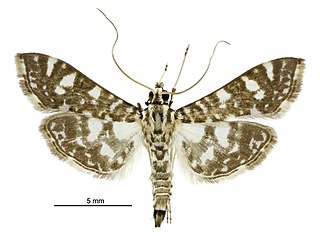
Sorghum or broomcorn is a genus of about 25 species of flowering plants in the grass family (Poaceae). Sorghum bicolor is grown as a cereal for human consumption and as animal fodder.

Anigozanthos is a genus of plant found naturally in the Southwestern Australia biogeographic region, belonging to the bloodwort family Haemodoraceae. The 11 species and their subspecies are commonly known as kangaroo paw or catspaw, depending on their size, and the shape and colour of their flowers. A further species, previously identified as Anigozanthos fuliginosus, was separated to a monotypic genus as Macropidia fuliginosa. All 11 species of Anigozanthos are endemic to the south west of Western Australia, Noongar Boodjar.

The blue ant, also known as the blue-ant or bluebottle, is a species of flower wasp in the family Thynnidae. It is the sole member of the genus Diamma and of the subfamily Diamminae. Despite its common name and wingless body, it is not an ant but rather a species of large, solitary, parasitic wasp.

The swamp wallaby is a small macropod marsupial of eastern Australia. This wallaby is also commonly known as the black wallaby, with other names including black-tailed wallaby, fern wallaby, black pademelon, stinker, and black stinker on account of its characteristic swampy odour.

Glyphodes is a genus of moths of the family Crambidae described by Achille Guenée in 1854.

Drosera bicolor is an erect perennial tuberous species in the genus Drosera that is endemic to Western Australia. It produces a basal rosette of leaves similar to that of D. peltata and the stem grows to 11 cm (4 in) high. Its white flowers that have a red spot near the petal base emerge from September to October. D. bicolor grows in deep silica sand on heathland along the upper Phillips River and south-east of Lake King.

Diaphania indica, the cucumber moth or cotton caterpillar, is a widespread but mainly Old World moth species. It belongs to the grass moth family, and therein to the large subfamily Spilomelinae. This moth occurs in many tropical and subtropical regions outside the Americas, though it is native to southern Asia; it is occasionally a significant pest of cucurbits and some other plants.
Glyphodes cyanomichla, the blue glyphodes moth, is a moth of the family Crambidae. It is endemic to the Hawaiian islands of Kauai, Oahu, Molokai and Hawaii.

Glyphodes bivitralis is a moth of the family Crambidae described by Achille Guenée in 1854. It is native to south-east Asia, including Hong Kong, India, Japan, Taiwan and Thailand. It is also found in Queensland, Hawaii and Maldives.
Huttonella bicolor is a species of land snail in the family Streptaxidae known commonly as the two-toned gulella.

Chabulina onychinalis, also known as the swan flower plant moth and until recently called Glyphodes onychinalis, is a moth of the family Crambidae. It is native to the Afro-Asian Region, including India, Sri Lanka, Hong Kong, Thailand, Indonesia, Japan, Australia and New Zealand, and has been recorded in California since 2000.

Glyphodes negatalis, the karanj defoliator, is a moth of the family Crambidae. The species was first described by Francis Walker in 1859. It has a wide range in the tropics, including South Africa, The Gambia, Mali, India, Sri Lanka, Hong Kong, Japan, and eastern Australia.

Glyphodes microta is a moth of the family Crambidae. It is found in Australia, where it ranges from the east coast to the west coast across the middle of the continent.

Glyphodes multilinealis, the fig-tiger-moth, is a species of moth of the family Crambidae described by George Hamilton Kenrick in 1907. It is found in Papua New Guinea, Fiji, Niue, the Cook Islands, the Society Islands, in Australia and Japan.

Glyphodes perspicualis is a species of moth of the family Crambidae. It was described by George Hamilton Kenrick in 1907 and it is found in Papua New Guinea.
Glyphodes doleschalii is a moth of the family Crambidae described by Julius Lederer in 1863. It is found in Queensland in northern Australia.

Glyphodes cyanomichla is a moth of the family Crambidae described by Frederic Moore in 1888. It is found in the Bengal region and in Taiwan.

Glyphodes pulverulentalis is a moth of the family Crambidae. It was first described by George Hampson in 1896.
Glyphodes basifascialis is a moth in the family Crambidae. It was described by George Hampson in 1899. It is found in Australia, Cameroon, the Democratic Republic of the Congo, the Seychelles, South Africa and Tanzania.

Kambo, also known as sapo or vacina-do-sapo, is substance derived from the natural secretions of an amphibian belonging to the Phyllomedusa family. Commonly the dried skin secretions of the giant leaf frog, known as the kambô in Portuguese, a species of frog, are used for ritualistic purposes with a strong religious and spiritual components. Less commonly it is used as a transdermal medicine, however, evidence for its effectiveness is limited.

















